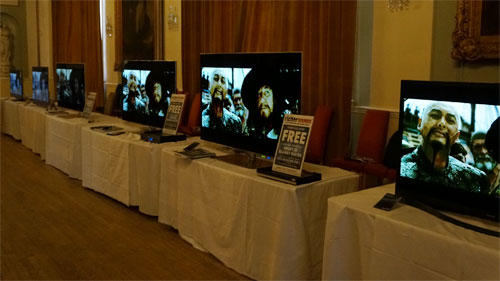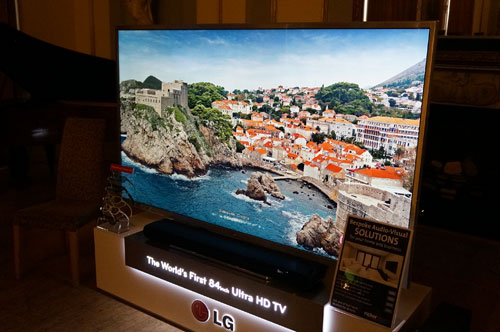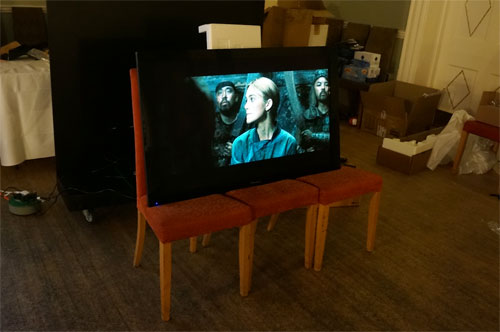A bank holiday Sunday – especially one as sunny as the one just passed – is typically not a day to find more than a hundred people loitering in a dimly lit banquet room.
But that’s exactly what happened at The City Rooms hotel in Leicester this past weekend. The reason is simple: the venue held host to several of the top flat-screen TVs released in 2013 by various manufacturers, all lined up side by side in their calibrated glory. The event – themed “Battle Of The Big Brand TVs” – was painstakingly put together by local THX calibrator Julian Scott and the Leicester store of Richer Sounds, with promotional and on-site support from the retailer’s national marketing department in conjunction with HDTVTest. Panasonic’s “Beyond The Reference” ZT plasma and its step-down VT series sibling, as well as Samsung’s much improved F8500 PDP (plasma display panel) offering, were among the HDTVs exhibited.
But unbeknownst to the crowd entering the room as the morning progressed, the star of the show was still boxed up in a corner, partially hidden behind a kiosk that was shipped in to hold the screen. But more on that later.

The TVs that were displayed from the outset were – in order from left to right – the Philips 46PFL8007T, the Samsung UE55F8000, and the Panasonic TX-L55WT65B LED LCD televisions; the Panasonic TX-P55VT65B, the Panasonic TX-P60ZT65B, the Samsung PS51F8500, and the Pioneer PDP-LX6090 plasmas; and perpendicular to the others, the LG 84LM960V 84-inch Ultra HD 4K TV.
The ultra high-definition (UHD) 84-incher garnered most of the attention early on, and for good reason. It was serving utterly gorgeous native 4K content, boasted a larger screen size than any other set on show, and was helped by an external surround sound system that pumped out resounding bass.

In contrast, the three LED LCDs on the left were ignored for the most part. This sort of setting – with only a small amount of ambient light present, which ironically is what videophiles like for critical viewing – really exposed the shallower blacks and narrower viewing angles of LCD display technology, particularly when compared against plasma TVs that are superior in these two aspects. Stores with bright lights is where LCDs thrive… not in this environment.
And when the Blu-ray player started spinning darker sequences from The Dark Knight Rises and Pirates Of The Caribbean: At World’s End (served via an HDMI amplifier to all the TVs), even the LG 84in 4K television – which uses edge LED backlighting – faltered. Almost every attendee could be found congregating in front of the four plasma televisions, mesmerised by the exceedingly deep blacks and realistic shadow detailing.
To my eyes, the Panasonic ZT65, VT65 and Pioneer LX6090 were neck and neck in terms of black-level response, with the Samsung F8500 sitting a slight notch below (although it was capable of the brightest whites during high APL scenes). In the presence of ambient light hitting the screen, the letterboxing black bars on the Kuro would grey out the most, indicating how far anti-reflection filter technology has come since 4 years ago. Between the ZT and VT, the former held on to its blacks better in brighter conditions. Personally, I’d be happy to use any of the four plasmas as my main display for critical viewing – such is the quality available today to consumers who wish to enjoy the big-screen cinematic experience at home.
But there remained a surprise in the box (which was mentioned earlier). You see, in it sat a Pioneer KRP-500A that was kindly loaned by one of our regular forum members, and had been calibrated by THX-certified calibrator Julian Scott (who also worked his magic on all the televisions on display). For those who don’t know, the KRP is widely regarded as the best in breed of the Kuro lineage, promising even lower minimum luminance level (MLL) than the LX series. It’s the Ferrari 250 GTO, the Lionel Messi, the Jessica Alba-equivalent in the Kuro world.
There’s only one problem – the KRP-500A did not come with a table-top stand or wall bracket. Without any way to support the screen securely, the organisers even flirted with the thought of keeping the TV in its box, never to be unleashed for the day. Fortunately, they eventually decided to take advantage of a spare moment (when the crowd’s attention was fully focused on a live demonstration of basic calibration conducted by Julian and our chief reviewer David Mackenzie) to prop the plasma screen on some chairs.

And it was truly worth it. The Kuro KRP exhibited a deeper shade of black than any of the TVs on show: for once, the black bezel (shown up by a tiny amount of stray light) was actually more visible to my eye than the letterbox bars. This is without doubt the deepest blacks I’ve seen from a calibrated flat-panel television to date – the unrivalled amount of dynamic range and pop made me wish I could revisit all the movies I’ve already watched on the KRP-500A again, even though the Panasonic ZT, VT and Samsung F8500 had a slight edge when it came to colour saturation (afforded by better calibration controls) and motion resolution.
I was so astounded by the KRP’s black-level performance, that I immediately asked the owner where he bought his set, and whether it was specially tweaked with voltage or firmware adjustments. The answer to the first question was Sevenoaks (a high-end home cinema retailer in the UK); and to the second, no.
We’ve seen a few Kuro KRPs in the field and in trade shows, but none performed to this level. The running theory proffered by David was that according to some industry insiders, before Pioneer ended its plasma production run, a selected batch of 50-inch KRP models actually contained modules and driver software intended for the third generation of Kuros (10G in Pioneer PDP speak) featuring “Infinite Black” technology, which, of course, ultimately never saw the light of day. The outstanding sample we were lucky enough to lay eyes upon over the weekend might have come from such a batch (affectionately referred to as 9.5G among informed Kuro owners).
Interestingly, both Pioneer Kuro owners who loaned their sets (the PDP-LX6090 and the KRP-500A) for the event said that they would rather keep their existing televisions after seeing the ZT65, VT65 and F8500 in action, but conceded that the ZT is the closest yet Panasonic has come to dethroning the Kuro as far as black level is concerned. In a straw poll of the attendees at a Q&A session towards the end, when asked which of the currently available TV would they buy if money was no object, almost everyone (including David and me) chose the Panasonic TX-P60ZT65.
Two other noteworthy snippets emerged during the Q&A session. First, Richer Sounds staff manning the event disclosed that plasma displays account for such a minuscule proportion of the company’s TV sales that its bottom line wouldn’t be dented one bit should it stop selling plasmas tomorrow. It’s in light of this revelation that the Richer Sounds team’s dedication to an event such as this which heavily favours plasma TVs became all the more admirable – they were helpful, knowledgeable and enthusiastic, totally appreciating the various attributes of picture quality as well as the need to achieve accuracy through calibration. Even for seasoned reviewers like us who have a number of HDTV displays passing through our test room on a weekly basis, it’s very rare for us to see them all calibrated side-by-side due to the usually limited loan period, so this type of event will always get our full support – a very big thanks to Jules, Jeff, Tim, Ben and everyone who made it happen.
Second, a Panasonic spokesperson present at the event admitted that the Japanese manufacturer is gradually shifting its R&D resources from PDP to 4K OLED (for example the 56-inch prototype we first saw at CES 2013 in Las Vegas), claiming that the 3D printing method used will result in higher yield rates than what is possible from Korean rivals LG and Samsung who have struggled thus far to put their respective OLED TV models on store shelves.
Considering the less-than-rosy outlook facing plasma display technology on both the retail and manufacturing fronts, I believe that the black-level reproduction from the specific KRP-500A unit we saw on this occasion will probably never be beaten by another PDP. That a nearly 5-year-old set can still more than hold its own against all comers in terms of black level is the strongest testament yet of the extraordinary feat achieved by Pioneer’s engineers. The company might have pulled its plug on plasmas, but its Kuro legacy lives on.